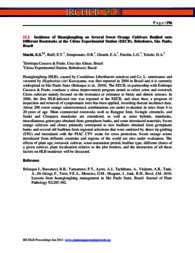Incidence of Huanglongbing on several sweet orange cultivars budded onto different rootstocks at the Citrus Experimental Station (EECB), Bebedouro, São Paulo, Brazil.
Incidence of Huanglongbing on several sweet orange cultivars budded onto different rootstocks at the Citrus Experimental Station (EECB), Bebedouro, São Paulo, Brazil.
Author(s): STUCHI, E. S.; REIFF, E. T; SEMPIONATO, O. R.; GIRARDI, E. A.; TOLEDO, D. A.
Summary: Huanglongbing (HLB), caused by Candidatus Liberibacter asiaticus and Ca. L. americanus and vectored by Diaphorina citri Kuwayama, was first reported in 2004 in Brazil and it is currently widespread in São Paulo State (Belasque et al., 2010). The EECB, in partnership with Embrapa Cassava & Fruits, conducts a citrus improvement program aimed to select scion and rootstock Citrus cultivars mainly focused on the resistance or tolerance to biotic and abiotic stresses.
Publication year: 2011
Types of publication: Abstract in annals or event proceedings
Unit: Embrapa Cassava & Fruits
Keywords: HLB, Huanglongbing
Observation
Some of Embrapa's publications are published as ePub files. To read them, use or download one of the following free software options to your computer or mobile device. Android: Google Play Books; IOS: iBooks; Windows and Linux: Calibre.
Access other publications
Access the Agricultural Research Database (BDPA) to consult Embrapa's full library collection and records.
Visit Embrapa Bookstore to purchase books and other publications sold by Embrapa.

